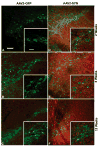Targeted overexpression of human alpha-synuclein triggers microglial activation and an adaptive immune response in a mouse model of Parkinson disease
- PMID: 19018246
- PMCID: PMC2753200
- DOI: 10.1097/NEN.0b013e31818e5e99
Targeted overexpression of human alpha-synuclein triggers microglial activation and an adaptive immune response in a mouse model of Parkinson disease
Abstract
Microglial activation and adaptive immunity have been implicated in the neurodegenerative processes in Parkinson disease. It has been proposed that these responses may be triggered by modified forms of alpha-synuclein (alpha-SYN), particularly nitrated species, which are released as a consequence of dopaminergic neurodegeneration. To examine the relationship between alpha-SYN, microglial activation, and adaptive immunity, we used a mouse model of Parkinson disease in which human alpha-SYN is overexpressed by a recombinant adeno-associated virus vector, serotype 2 (AAV2-SYN); this overexpression leads to slow degeneration of dopaminergic neurons. Microglial activation and components of the adaptive immune response were assessed using immunohistochemistry; quantitative polymerase chain reaction was used to examine cytokine expression. Four weeks after injection, there was a marked increase in CD68-positive microglia and greater infiltration of B and T lymphocytes in the substantia nigra pars compacta of the AAV2-SYN group than in controls. At 12 weeks, CD68 staining declined, but B- and T-cell infiltration persisted. Expression of proinflammatory cytokines was enhanced, whereas markers of alternative activation (i.e. arginase I and interleukins 4 and 13) were not altered. Increased immunoreactivity for mouse immunoglobulin was detected at all time points in the AAV2-SYN animals. These data show that overexpression of alpha-SYN alone, in the absence of overt neurodegeneration, is sufficient to trigger neuroinflammation with both microglial activation and stimulation of adaptive immunity.
Figures











References
-
- McGeer PL, Itagaki S, Boyes BE, McGeer EG. Reactive microglia are positive for HLA-DR in the substantia nigra of Parkinson’s and Alzheimer’s disease brains. Neurology. 1988;38:1285–91. - PubMed
-
- McGeer PL, Schwab C, Parent A, Doudet D. Presence of reactive microglia in monkey substantia nigra years after 1-methyl-4-phenyl-1,2,3,6-tetrahydropyridine administration. Ann Neurol. 2003;54:599–604. - PubMed
-
- Sherer TB, Betarbet R, Kim JH, Greenamyre JT. Selective microglial activation in the rat rotenone model of Parkinson’s disease. Neurosci Lett. 2003;341:87–90. - PubMed
-
- Kurkowska-Jastrzebska I, Wronska A, Kohutnicka M, Czlonkowski A, Czlonkowska A. The inflammatory reaction following 1-methyl-4-phenyl-1,2,3, 6-tetrahydropyridine intoxication in mouse. Exp Neurol. 1999;156:50–61. - PubMed
-
- Reynolds AD, Banerjee R, Liu J, Gendelman HE, Mosley RL. Neuroprotective activities of CD4+CD25+ regulatory T cells in an animal model of Parkinson’s disease. J Leukoc Biol. 2007;82:1083–94. - PubMed
Publication types
MeSH terms
Substances
Grants and funding
LinkOut - more resources
Full Text Sources
Other Literature Sources
Medical
Miscellaneous

